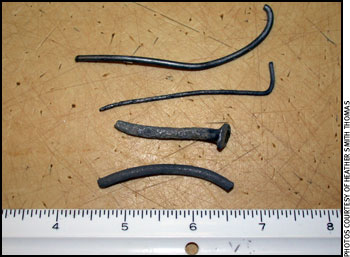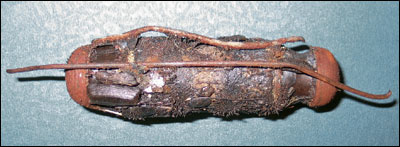Hardware Disease in Cattle

Veterinarian David Steffen of the Veterinary Diagnostic Center at the University of Nebraska–Lincoln, says the overwhelming majority of foreign objects found in cattle stomachs are pieces of wire 2 inches (in.) to 5.5 in. long.
Cattle eat quickly, without sorting their feed. They often ingest foreign material, especially when eating hay or processed feed. Veterinarian David Steffen of the Veterinary Diagnostic Center at the University of Nebraska–Lincoln, says the overwhelming majority of foreign objects found in cattle stomachs are pieces of wire 2 inches (in.) to 5.5 in. long.
"If shorter, they probably pass through the stomachs without causing a problem," he says.
Foreign objects that don't pass through usually fall into the reticulum. Contractions of this stomach during normal digestion may push them through the stomach wall. The reticulum lies against the diaphragm.
"If the sharp object makes it through the diaphragm, it may penetrate the pericardial sac around the heart," he says.

A magnet can be used to collect metal pieces in the digestive system.
Cows may ingest fence staples, barn nails, bits of wire or any other objects that find their way into the feed. Old fence wire lying in a field, with the hay grown up around it, may be chopped up by the swather and baler, ending up in hay. Nails, roofing tacks or other sharp metal objects are often found around a barnyard or a junk pile that cattle have access to when grazing. In feedlots, metal pieces may come off feed-handling equipment and be mixed with the feed. There are also some instances of non-metallic sharp objects (such as small sharp rocks) penetrating the stomach wall.
"Sometimes we find the offending object at necropsy, and sometimes it's small enough to get lost in the stomach contents and we don't find it," Steffen says. "Sometimes it passes on through after it causes the damage that creates an infection."
It's not always easy to diagnose "hardware disease" because the signs are not very specific. "If the cow has a localized abscess, she goes off feed and looks a little dull. By the time she shows signs of heart failure, the heart sac is already severely damaged, and it's too late," says Steffen.
Some people give a magnet when they see early signs of possible hardware problems.
"If a metal object has just started to poke into the wall, putting the magnet into the stomach might pull it back into the reticulum and keep it somewhere safe where it won't penetrate all the way through," he says. Once the wire goes all the way through the wall and starts a case of peritonitis, however, the cow is still at risk for fatal infection.

[Click here to go to the top of the page.]











